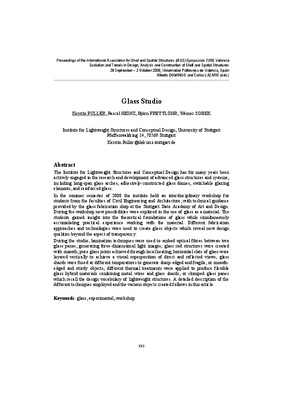JavaScript is disabled for your browser. Some features of this site may not work without it.
Buscar en RiuNet
Listar
Mi cuenta
Estadísticas
Ayuda RiuNet
Admin. UPV
Glass Studio
Mostrar el registro sencillo del ítem
Ficheros en el ítem
| dc.contributor.author | PULLER, Kerstin
|
|
| dc.contributor.author | HEINZ, Pascal
|
|
| dc.contributor.author | FRETTLÖHR, Björn
|
|
| dc.contributor.author | SOBEK, Werner
|
|
| dc.contributor.editor | Domingo Cabo, Alberto
|
es_ES |
| dc.contributor.editor | Lázaro Fernández, Carlos Manuel
|
es_ES |
| dc.date.accessioned | 2010-01-26T12:49:03Z | |
| dc.date.available | 2010-01-26T12:49:03Z | |
| dc.date.issued | 2010-01-26T12:49:03Z | |
| dc.identifier.isbn | 978-84-8363-461-5 | |
| dc.identifier.uri | http://hdl.handle.net/10251/6950 | |
| dc.description | p. 843-847 | en_EN |
| dc.description.abstract | The Institute for Lightweight Structures and Conceptual Design has for many years been actively engaged in the research and development of advanced glass structures and systems, including long-span glass arches, adhesively-constructed glass domes, switchable glazing elements, and reinforced glass. In the summer semester of 2008 the institute held an interdisciplinary workshop for students from the faculties of Civil Engineering and Architecture, with technical guidance provided by the glass fabrication shop at the Stuttgart State Academy of Art and Design. During the workshop new possibilities were explored in the use of glass as a material. The students gained insight into the theoretical foundations of glass while simultaneously accumulating practical experience working with the material. Different fabrication approaches and technologies were used to create glass objects which reveal new design qualities beyond the aspect of transparency. During the studio, lamination techniques were used to embed optical fibres between two glass panes, generating three-dimensional light images; glass rod structures were created with smooth, pure glass joints achieved through local heating; horizontal slats of glass were layered vertically to achieve a visual superposition of direct and reflected views; glass shards were fused at different temperatures to generate sharp-edged and fragile, or smoothedged and sturdy objects; different thermal treatments were applied to produce flexible glass hybrid materials combining metal wires and glass shards, or slumped glass panes which recall the design vocabulary of lightweight structures. A detailed description of the different techniques employed and the various objects created follows in this article. | en_EN |
| dc.language | Inglés | en_EN |
| dc.publisher | Editorial Universitat Politècnica de València | es_ES |
| dc.relation.ispartof | Symposium of the International Association for Shell and Spatial Structures (50th. 2009. Valencia). Evolution and Trends in Design, Analysis and Construction of Shell and Spatial Structures : Proceedings | en_EN |
| dc.rights | Reserva de todos los derechos | en_EN |
| dc.subject | Glass | en_EN |
| dc.subject | Experimental | en_EN |
| dc.subject | Workshop | en_EN |
| dc.title | Glass Studio | en_EN |
| dc.type | Comunicación en congreso | en_EN |
| dc.rights.accessRights | Abierto | es_ES |
| dc.description.bibliographicCitation | Puller, K.; Heinz, P.; Frettlöhr, B.; Sobek, W. (2010). Glass Studio. Editorial Universitat Politècnica de València. http://hdl.handle.net/10251/6950 | es_ES |
| dc.relation.conferencename | Symposium of the International Association for Shell and Spatial Structures | es_ES |
| dc.relation.conferencedate | 2009 | es_ES |
| dc.relation.conferenceplace | Valencia | es_ES |






